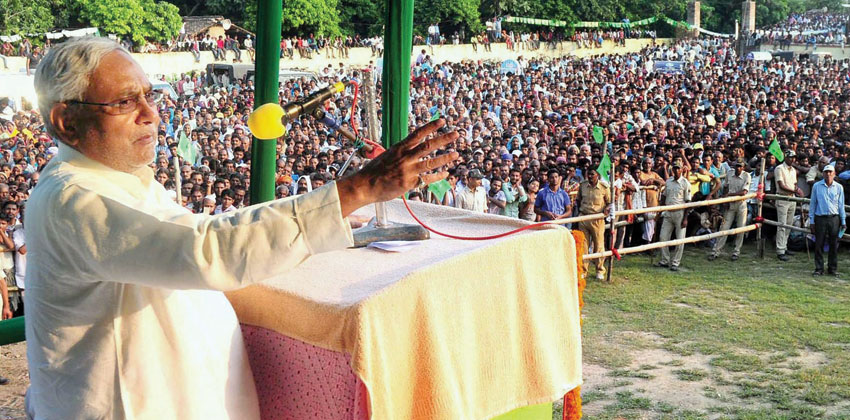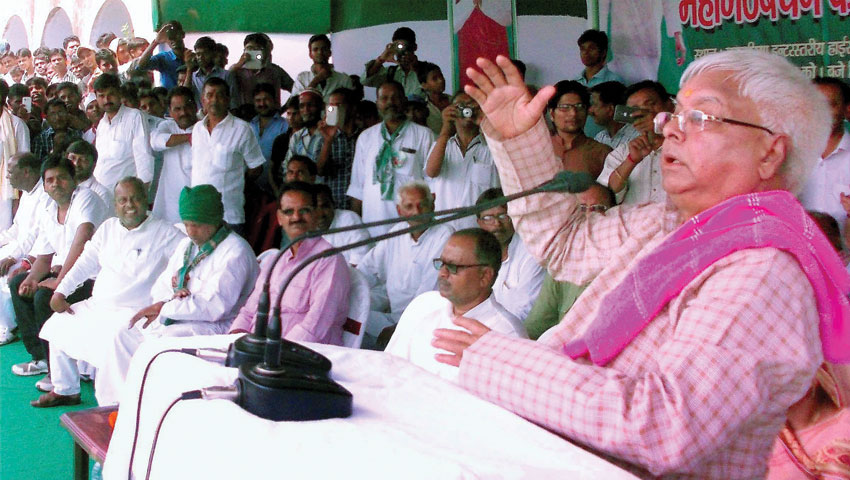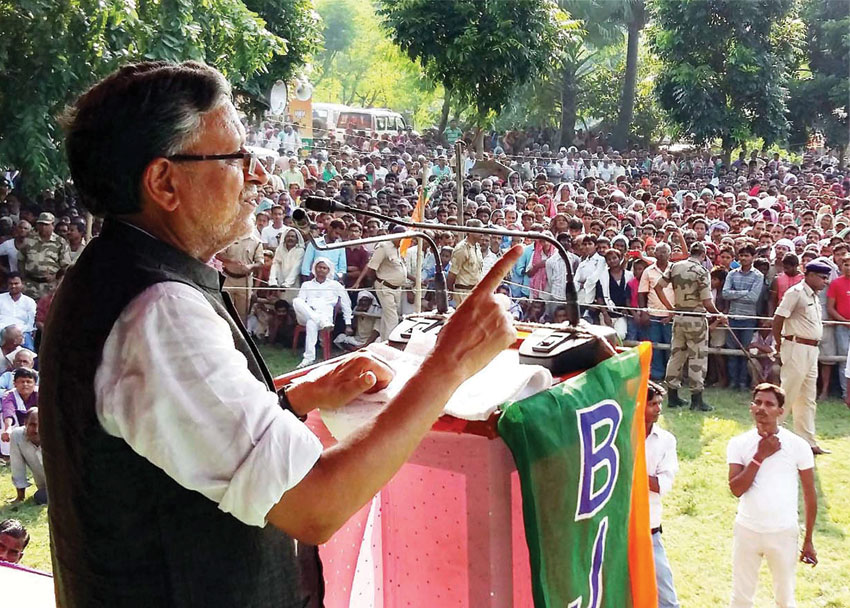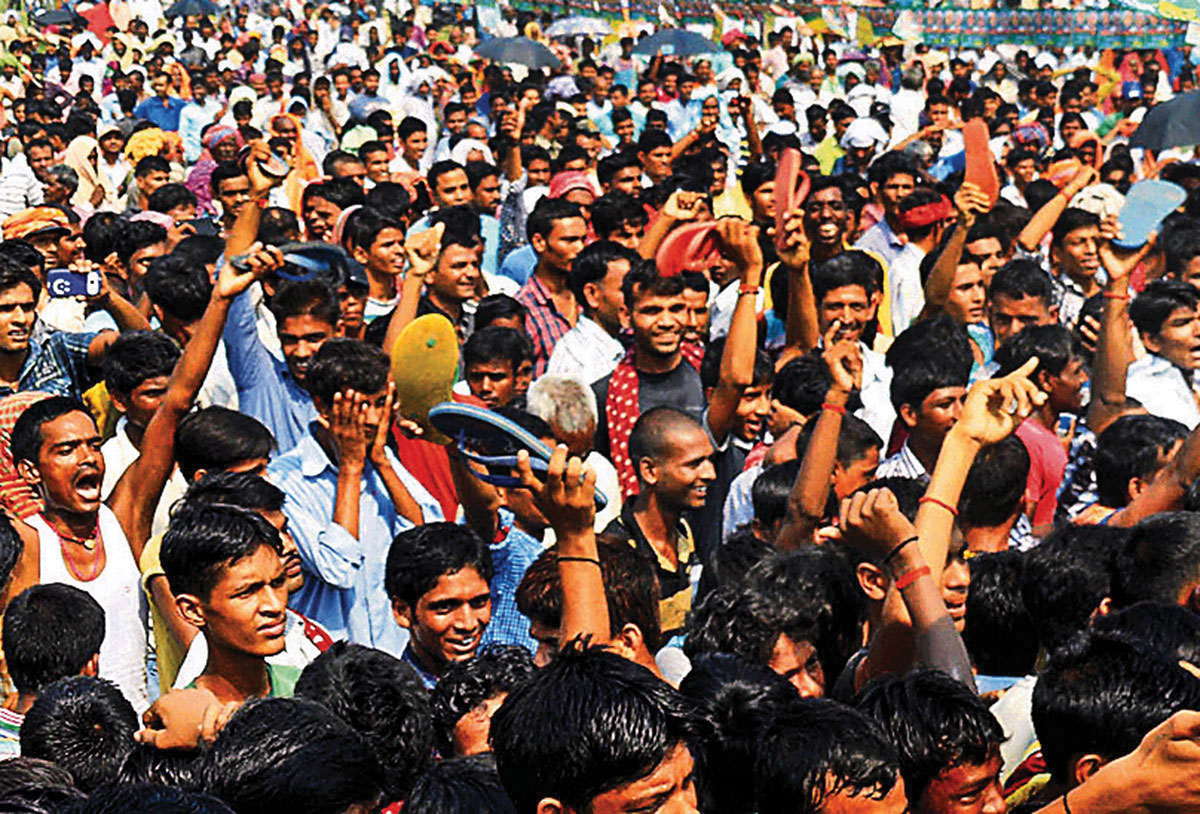CLASH OF THE BIHARI TITANS
A group of youths wave slippers during public address by Bihar Chief Minister Nitish Kumar (not in picture) in support of JD(U) candidate and sitting MLA from Warisaliganj in Nawada, Bihar, Sept. 29. (Press Trust of India)
The upcoming Bihar elections has the potential to be a landmark if the clashing political titans are able to unfold a new stage of growth, the non-accomplishment of which would be an undisrupted chapter of unfulfilled hopes and dreams, writes Priyanka Bhardwaj.
Voters in the eastern state of Bihar, in India, will get to exercise their democratic rights once again in the forthcoming assembly polls to be held in five phases from Oct. 12 to Nov. 5 as the tenure of the present one comes to an end, Nov. 29.
Contesting in these elections to a total of 243 constituencies, spread over 36 districts, are major political parties of the country that have been strategizing and re-formulating grand plans of seat sharing, social engineering and other such techniques of alliance-making in order to maximize their electoral-chances.

Prominent parties in this many layered fray are: the ruling Janata Dal (United) led by Nitish Kumar, Janata Dal (Secular) or JD (S), Rashtriya Janata Dal (RJD), Bharaitya Janta Party (BJP), Bahujan Samaj Party (BSP), Shiv Sena, Hindustani Awam Morcha (HAM), Samajwadi Party (SP), Indian National Congress (INC), Indian National Lok Dal (INLD), Rashtriya Lok Samta Party (RLSP), Lok Janshakti Party (LJP), All India Majlis-e-Ittehadul Muslimeen (AIMIM) and various Left Parties.
Since mid-August opposing parties have been adopting various positions.
First it was the six political entities — SP, JD (U), JD (S), RJD, INC & INLD led by JD (U) that came together to form the “Janata Parivaar.”
However competing claims over seat-allocation and other issues led to the fizzling out of constituents and all that is left of it is the “mahagathbandhan” (grand alliance).

This is a venture of Nitish’s JD (U) and Lalu’s RJD with both parties resolving to contest in 100 constituencies each.
The announcement of the list of candidates of this alliance was deliberately delayed for fears of rebellion and possible desertion by disgruntled lot.
Once foes, Nitish and Lalu evidently joined hands to fight off their new, common enemy, NDA led by the BJP.
Considering the fact that Nitish is yet to recover from the drubbing he received in the last Lok Sabha elections when he broke ties with the NDA, analysts are doubtful if he can successfully convince his Kurmi- voter base, nurtured on an anti-Lalu sentiment, to vote for his grand alliance.
Fuelling this hypothesis are field reports that the two constituent parties are running separate campaigns.
Keen to retain the Chief Ministerial seat Nitish is leaving no stone unturned and his party has initialed unique electoral campaigns: “Har Ghar Dastak” (knock on every door), deployment of “Jan Bhagidaari Manchs” (audio visual vans) and “Bihar Samman Sammelan” being organized in Delhi and Mumbai to connect with the Bihari diaspora.

In direct competition to Nitish’s campaigns, workers of the BJP led NDA too have a packed schedule in micromanaging the elections.
Not less than 600 rallies would be addressed in the poll bound and one chartered GPS monitored “raths” (vans) has been installed for every constituency to touch all 40,000 villages and star campaigner, Prime Minister Narendra Modi has been canvassing within and outside the state, where Bihari migrants live in huge concentrations.
During his inaugural visit to the IIT campus at Patna, Modi stressed on the development plank of the party and announced Rs.1, 250 billion package for the state.
There is no word on the name of the NDA’s Chief Ministerial candidate and this alliance’s seat distribution among its assorted members is as such: BJP would be contesting from 160 seats, LJP from 40 seats, RLSP from 23 seats and HAM from 20 seats.
It is not as if Amit Shah’s chief strategist of the BJP is giving “caste-arithmetic” a miss in the highly caste ridden social make up of the state.
He is attempting to balance the representations from the upper-caste with the backward-caste to prevent any polarization of Hindu votes.
In order to get the Yaduvanshis into the BJP fold Shah’s efforts are to drive a wedge into the Muslim-Yadav combine and to this effect the BJP has launched 22 Yadav candidates.
Yadavs are essentially a backward community and make about 14.6% of Bihar’s population.
Along with Muslims that are about 16% of the state’s population, they have been a formidable “secular-combine” that has always propelled Lalu to power and prevented the BJP from mustering strength.
In interesting times as these while in Bihar the BJP has adopted an anti-reservation avatar, it is being challenged by the quota stir in its home turf, Gujarat where the Patel agitation is threatening a social churning and realignment of political alignments.
Coming back to Bihar’s political stage, Shiv Sena, another of BJP’s allies in Maharashtra, has also joined the race, seeking to widen its base in the Hindi belt on the strength of its ideology and regional work.
Another debutant is Asaduddin Owaisi of AIMIM whose target is the Muslim vote bank in 24 seats mainly in the Seemanchal region, “without acquiescing to the lures of alliances” going by his words.
No to be missed, “Behan” Mayawati of BSP has also fielded her candidates as also the INC that is concentrating only on 40 constituencies.
Finally a third front – Socialist Secular Morcha has also come into existence in this manner: SP- 85 seats, Janadhikar Party – 64, National Congress Party – 40, Samras Samaj Party – 28, Samajwadi Janta Party – 23 and National People’s Party – 3.
It is not as if the poll-specter is limited to castes and parties.
Lineages too are big issues as it is “son-rise” times and dynasts are cornering for themselves a lions’ share of the significant but “safe” seats.
None could be more vocal than Lalu who roared, “Do you expect my sons to take out cattle to graze?”
By passing on mammoth responsibilities to son Tejaswi, he has ensured that the succession-anointment is complete both in terms of public display and implementation.
Likewise Chiraj Paswan, Member of Parliament from Jamui and son of Ram Vilas Paswan, heading LJP is seeking his re-election while leading from the front.
A bunch of sons being promoted by their fathers are C.P. Thakur’s son Vivek Thanku from Brahampur, former Chief Minister, Jagganath Mishra whose son Nitish Mishra is seeking re-election, Ashwini Choubey’s son Arjit Shashwat, Lalu’s other son, Tej Pratap Yadav from Mahua, Jitan Kumar Manjhi’s (HAMS) son, Santosh Kumar from Kutumba, Rajesh Kumar, son of Shakuni Choudhary (HAMS) from Khagaria, Mehmood Ali Qaiser’s (LJP) son, Salahuddin Yaruf from Simri Bakhtiyarpur, Ram Chandra Paswan’s (LNJP) son Prince Raj from Kalyanpur, Ashwini Choubey’s (BJP) son, Arjit Shashwat from Bhagalpur, and Ganga Prasad’s (BJP) son, Sanjeev Chaurasia from Digha.
The high voltage elections will also reveal there have been changes in winning pattern of candidates with criminal antecedents.
An analysis by the Association of Democratic Reforms & Bihar Election Watch of last decade’s political candidates showed that about 32% of them had criminal cases registered against them (with 20% of serious nature) while the chances of winning an election with criminal records came to about 19%.
The upcoming elections therefore has the potential to be a landmark if the clashing political titans are able to unfold a new stage of growth, the non-accomplishment of which would be an undisrupted chapter of unfulfilled hopes and dreams.


